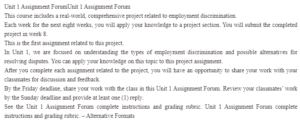Employee Discrimination and Conflict Resolution
Types of employment discrimination and their potential impact on GreenTech Ltd.
According to Walsh (2015), employment discrimination is the denial or limitation of employment opportunities based on a person’s attributes, such as gender, race, and ethnic group. One type of discrimination encountered in many organizations is retaliation. Walsh (2015) defines retaliation as punishing employees to discourage them from pursuing their rights under antidiscrimination laws or helping others do so. The second type of discrimination is disparate treatment, which is the deliberate unequal treatment based on attributes resulting in the denial or limitation of employment opportunities. The two types of discrimination could significantly impact GreenTech Ltd.’s success and operations. For example, disparate treatment can lead to expensive lawsuits that drain GreenTech Ltd.’s financials. Another impact of disparate treatment is lousy publicity, which could ruin the company’s reputation. The main impact of disparate treatment on employees at GreenTech Ltd. is demotivation. Demotivation could arise from feeling unappreciated. Retaliation may create conflict between employees and management at GreenTech Ltd. and reduce employee productivity, particularly when the employer denies employees the opportunity to seek good working conditions and increased pay.
Alternatives to litigation to resolving the employment disputes identified above.
The employment disputes arising from retaliation and disparate treatment are arbitration and mediation. Arbitration is a conflict resolution method that involves a third party who makes a binding decision on the issue causing the conflict based on the evidence presented by the conflicting parties(Schultz & Grant, 2021). Mediation involves a third party who acts as an independent party facilitating discussion between the conflicting parties. A mediator may use a transformative, evaluative, or facilitative approach (Chern, 2020). The evaluative approach includes weighing options and making recommendations based on the mediator’s experience. The facilitative approach includes asking questions, normalizing viewpoints, and validating all parties’ views. In contrast, the transformative approach includes creating space for the conflicting parties to express their emotions through the conflict resolution process to facilitate recognition and empowerment.
Mediation is viewed as an informal process facilitating the effective resolution of a conflict. Conversely, arbitration is a formal and structured process that includes various steps. The first step is hearing the arguments made by the conflicting parties. The second is engaging in a long pre-trial process involving discovery. The third is pleadings and preparation of witness statements. The fourth step is cross-examining the conflicting parties. The fifth step is issuing a detailed written decision after hearing the arguments made by the conflicting parties. The main types of arbitration are administered and ad hoc arbitrations. A professional arbitration body offers administered arbitrations. Ad hoc arbitration includes using arbitral tribunals appointed by the conflicting parties or an appointing authority selected by the parties. According to Joongi (2017), the primary duties of a tribunal include acting neutrally and objectively between the conflicting parties. Secondly, allow every party a rational opportunity to express themselves. Lastly, deal with the case and adopt suitable procedures based on the situation leading to the conflict to offer a fair resolution.
A human resource manager must create a conducive work environment and deal with any conflicts that could affect employee performance. In creating a conducive environment, the human resource manager must understand employees’ needs and grievances and negotiate to develop a mutually beneficial agreement. This requires understanding issues that could create conflict in the workplace and how to resolve them. Human resource managers must also understand conflict resolution strategies to manage employee differences. The differences may arise from opinions among employees and between employees and management. A human resource manager should also locate tension points in the workplace. This can be achieved by understanding the types of conflicts that could arise in the workplace and how to prevent them. Creating an environment where employees feel free to express themselves is also essential to avoid creating tension that can escalate conflicts and affect employee productivity.
References
Chern, C. (2020). Mediation styles. International Commercial Mediation, 129-139. https://doi.org/10.4324/9781003122845-8
Joongi, K. (2017). Arbitration procedure. International Arbitration in Korea. https://doi.org/10.1093/law/9780198755432.003.0006
Schultz, T., & Grant, T. (2021). What is arbitration, and where does it come from? Arbitration: A Very Short Introduction, 1-22. https://doi.org/10.1093/actrade/9780198738749.003.0001
Walsh, D. J. (2015). Employment law for human resource practice. Cengage Learning.
ORDER A PLAGIARISM-FREE PAPER HERE
We’ll write everything from scratch
Question

Employee Discrimination and Conflict Resolution
Unit 1 Assignment ForumUnit 1 Assignment Forum
This course includes a real-world, comprehensive project related to employment discrimination.
Each week for the next eight weeks, you will apply your knowledge to a project section. You will submit the completed project in week 8.
This is the first assignment related to this project.
In Unit 1, we are focused on understanding the types of employment discrimination and possible alternatives for resolving disputes. You can apply your knowledge on this topic to this project assignment.
After you complete each assignment related to the project, you will have an opportunity to share your work with your classmates for discussion and feedback.
By the Friday deadline, share your work with the class in this Unit 1 Assignment Forum. Review your classmates’ work by the Sunday deadline and provide at least one (1) reply.
See the Unit 1 Assignment Forum complete instructions and grading rubric. Unit 1 Assignment Forum full instructions and grading rubric. – Alternative Formats

